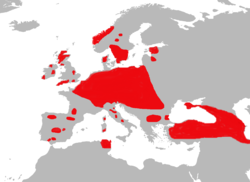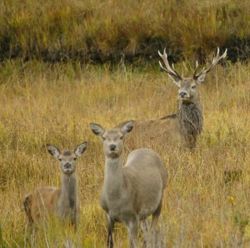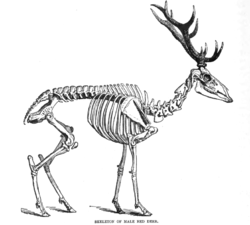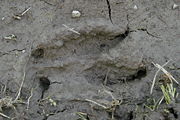Red Deer
2008/9 Schools Wikipedia Selection. Related subjects: Mammals
| Red Deer | ||||||||||||||||||
|---|---|---|---|---|---|---|---|---|---|---|---|---|---|---|---|---|---|---|
 Male (Stag)  Female (Hind)
|
||||||||||||||||||
| Conservation status | ||||||||||||||||||
| Scientific classification | ||||||||||||||||||
|
||||||||||||||||||
| Binomial name | ||||||||||||||||||
| Cervus elaphus Linnaeus, 1758 |
||||||||||||||||||
 Range of Cervus elaphus
|
The Red Deer (Cervus elaphus) is one of the largest deer species. The Red Deer inhabits most of Europe, the Caucasus Mountains region, Asia Minor and parts of western and central Asia. It also inhabits the Atlas Mountains region between Algeria and Tunisia in northwestern Africa, being the only species of deer to inhabit Africa. Red Deer have been introduced to other areas including New Zealand and Argentina. In many parts of the world the meat ( venison) from Red Deer is widely used as a food source.
Red Deer are ruminants, characterized by an even number of toes, and a four-chambered stomach. Recent DNA evidence indicates that the Red Deer (Cervus elaphus) and the East Asian and North American Elk (Wapiti) (Cervus canadensis) represent two distinct species. They give also hint for an additional primordial subgroup of Central Asian Red Deer. . The ancestor of all Red Deer probably originated in Central Asia and probably resembled Sika Deer.
Although at one time Red Deer were rare in some areas, they were never close to extinction. Reintroduction and conservation efforts, especially in the United Kingdom, have resulted in an increase of Red Deer populations, while other areas, such as North Africa, have continued to show a population decline.
Description
The Red Deer is a large ungulate (hoofed animal). Only two species of deer are larger: the moose (Alces alces), known in Europe as the elk, and the Wapiti or Elk (Cervus canadensis) of North America and East Asia.
It is a ruminant, eating its food in two stages and having an even number of toes on each hoof, similar to camels, goats and cattle. European Red Deer have a longer relative tail length compared to their Asian and North American relatives. There are subtle differences in appearance between the various subspecies of Red Deer primarily in size and antlers with the smallest being the Corsican Red Deer found on the islands of Corsica and Sardinia and the largest being the East European red deer (or maral) of Asia Minor and the Caucasus Region to the west of the Caspian Sea. The deer of Central and Western Europe vary greatly in size with some of the largest deer found in the Carpathian Mountains in Central Europe. West European Red Deer historically, grew to large size given ample food supply (including peoples' crops), and descendants of introduced populations living in New Zealand and Argentina have grown quite large in size and antlers. East European Red Deer stags and West European Red Deer stags of the Carpathian Mountains may rival the Wapiti in size. Note that the large size is applied to male deer only. Female Red Deer are much smaller.
Generally, the average male (stag) Red Deer of Europe is 1.2 metres (4 ft) tall and weighs 295 kilograms (650 lb). European Red Deer tend to be reddish-brown in their summer coats. The males of many subspecies also grow a short neck mane ("mane" of hair around their necks) during the autumn. The male deer of the British Isles and Norway tend to have the thickest and most noticeable neck manes, relative to the other subspecies. Male East European Red Deer (Cervus elaphus maral) and Spanish Red Deer (Cervus elaphus hispanicus) do not carry neck manes. Male deer of all subspecies, however, tend to have stronger and thicker neck muscles than female deer, which may give them an appearance of having neck manes. Red Deer hinds (females) do not have neck manes. The European Red Deer is adapted to a woodland environment. All Red Deer subspecies are between 2.1 and 2.4 metres (7 to 8 ft) in length from nose to tail.
Only the stags have antlers which start growing in the spring and are shed each year, usually at the end of winter. Antlers are made of bone which can grow at a rate of 2.5 centimetres (1 in) a day. A soft covering known as velvet helps to protect newly forming antlers in the spring. European red deer antlers are distinctive in being rather straight and rugose, with the fourth and fifth tines forming a "crown" or "cup" in larger males. Any tines in excess of the fourth and fifth tine will grow radially from the "cup". "Cups" are generally absent in the antlers of smaller red deer such as Corsican Red Deer. West European Red Deer antlers feature bez (second) tines that are either absent or smaller than the brow tine. However, bez tines occur frequently in Norwegian Red Deer. Antlers of East European red deer carry large bez (second) tines and form less-developed "cups" than West European red deer. A stag can (exceptionally) have smooth antlers, and is then known as a switch. Similarly, a stag that doesn't grow antlers is a hummel. The antlers are testosterone driven and as the stag's testosterone levels drop in the autumn, the velvet is shed and the antlers stop growing.
During the autumn, all Red Deer subspecies grow a thicker coat of hair which helps to insulate them during the winter. Autumn is also when some of the stags grow their neck manes. It is in the autumn/winter coat that distinguishes most subspecies. The East European Red Deer's winter coat is greyer and has a larger and more distinguished light rump-patch (similar to Wapitis and some Central Asian Red Deer) compared to the West European Red Deer which is more of a greyish-brown coat with a darker yellowish rump patch in the winter. By the time summer begins, the heavy winter coat has been shed; the animals are known to rub against trees and other objects to help remove hair from their bodies. Red Deer have different colouration based on the seasons and types of habitats, with grey or lighter colouration prevalent in the winter and a more reddish and darker coat in the summer. Most European Red Deer wear a reddish-brown summer coat, and some individuals may have a few spots on the backs of their summer coats.
Distribution and habitat

Cervus genus ancestors of Red Deer first appear in fossil records 12 million years ago during the Pliocene in Eurasia. An extinct species, known as the Irish Elk (Megaloceros) was not related to the red deer but to the fallow deer, was the largest member of the deer family known from the fossil record.
The European Red Deer is one of the largest game animals found in Southwestern Asia (Asia Minor and Caucasus Regions), North Africa and Europe. In Europe, The Red Deer is the largest non-domesticated mammal still existing in some countries such as the United Kingdom and Ireland. A deer known as the "Barbary Stag" and resembles the West European Red Deer, is the only member of the deer family that is represented in Africa, with population centred in the northwestern region of the continent in the Atlas Mountains. As of the mid 1990s, Morocco, Tunisia and Algeria were the only African countries known to have Red Deer.
In New Zealand, and to a much lesser degree in Australia, introduced Red Deer have adapted well and are widely hunted. Red Deer populations in Africa and southern Europe are generally declining. In Argentina, where the Red Deer has had a potential negative impact on native animal species, the International Union for Conservation of Nature and Natural Resources has labelled the animal as one of the world's 100 worst invaders.
Migration
Red Deer in Europe generally spend their winters in lower altitudes and more wooded terrain. During the summer, they migrate to higher elevations where food supplies are greater for the calving season.
Taxonomy
Biologists have until recently stated that Red Deer and Wapiti (or Elk) are the same species forming a continuous distribution throughout temperate Eurasia and North America, based on fertile hybrids that have been produced under captive conditions. Animal behaviour is generally different in captivity than in the wild, and the assumption that the same results would happen in the wild as in captivity is not necessarily the best test methodology to determine speciation.
Recent DNA studies conducted on hundreds of samples from Red Deer and Elk subspecies concluded, that that not more than 9 distinct subspecies of Red Deer exist and that they should be considered to be two separate species. The Wapiti or Elk from Northern and Eastern Asia and North America and the Red Deer from Europe, western Asia and North Africa represent two distinct species. Surprisingly the Elk is more closely related in DNA to the Sika Deer and to Thorold's deer than to the Red Deer.
Subspecies
Additionally there are some central asiatic subspecies (Tarim group, including Bactrian deer and Yarkand deer), which are geographically isolated from Wapitis and western Red Deer by the Takla Makan and the Pamir Mountains. They represent a primordial subgroup, which is genetically more related to the Red Deer than to the Wapitis.
The International Union for Conservation of Nature and Natural Resources originally listed nine subspecies of Red Deer (Cervus elaphus): three as endangered, one as vulnerable, one as near threatened, and four without enough data to give a category ("Data Deficient"). The species as a whole, however, is listed as least concern.. However, this was based on the classification of Red Deer as one species (Cervus elaphus) that included Wapitis.
Listed below are the subspecies of Red Deer (Cervus elaphus) including the primordial subgroup from central Asia.
| Name | Subspecies | Status | Historical range |
|---|---|---|---|
| Western European Red Deer | Cervus elaphus elaphus | Western Europe | |
| Eastern European Red deer | Cervus elaphus hippelaphus | Eastern Europe, Balkan | |
| Maral | Cervus elaphus maral | Asia Minor, Crimea, Caucasus Region and northwestern Iran | |
| Barbary stag | Cervus elaphus barbarus | Lower risk (Near threatened) | Morocco, Tunisia and Algeria |
| Corsican Red Deer | Cervus elaphus corsicanus | Endangered (D) | Corsica, Sardinia |
| Kashmir stag | Cervus elaphus hanglu | Endangered (D) | Kashmir |
| Bactrian deer | Cervus elaphus bactrianus | Vulnerable (D1) | Afghanistan, Kazakhstan, Turkmenistan, Usbekistan and Tadschikistan |
| Yarkand deer | Cervus elaphus yarkandensis | Endangered (A1a) | Xinjiang |
Behaviour
Mature Red Deer (Cervus elaphus) usually stay in single-sex groups for most of the year. During the mating ritual, called the rut, mature stags compete for the attentions of the hinds and will then try to defend hinds that they attract. Rival stags challenge opponents by bellowing and walking in parallel. This allows combatants to assess each other's antlers, body size and fighting prowess. If neither stag backs down a clash of antlers can occur, and stags sometimes sustain serious injuries.
Dominant stags follow groups of hinds during the rut, from August into early winter. The stags may have as many as 20 hinds to keep from other less attractive males. Only mature stags hold harems (groups of hinds) and breeding success peaks at about 8 years of age. Stags 2-4 years old rarely hold harems and spend most of the rut on the periphery of larger harems, as do stags over 11 years old. Young and old stags that do acquire a harem hold it later in the breeding season than those stags in their prime. Harem holding stags rarely feed and lose up to 20% of their body weight. Stags that enter the rut in poor condition are less likely to make it through to the peak conception period.
Male European Red Deer have a distinctive "roar" during the rut, which is an adaptation to forested environments, as opposed to male Wapiti (or American Elk) which "bugle" during the rut in adaptation to open environments. The male deer roars to keep his harem of females together. The females are initially attracted to those males that both roar most often and have the loudest roar call. Males also use the roar call when competing with other males for females during the rut, and along with other forms of posturing and antler fights, is a method used by the males to establish dominance. Roaring is most common during the early dawn and late evening, which is also when the crepuscular deer are most active in general.
Breeding, gestation and lifespan
Red Deer mating patterns usually involve a dozen or more mating attempts before the first successful one. There may be several more matings before the stag will seek out another mate in his harem. Females in their second autumn can produce one and very rarely two offspring per year. The gestation period is 240 and 262 days and the offspring weigh between 15 and 16 kilograms (33 to 35 lb). After two weeks, calves are able to join the herd and are fully weaned after two months. Female offspring outnumber male offspring more than two to one and all Red Deer calves are born spotted, as is common with many deer species, and lose their spots by the end of summer. However, as in many species of Old World Deer, some adults do retain a few spots on the backs of their summer coats. The offspring will remain with their mothers for almost one full year, leaving around the time that the next season offspring are produced. The gestation period is the same for all subspecies.
Red Deer live up to over 20 years in captivity and average 10 to 13 years in the wild, though some subspecies that have less predation pressure average 15 years.
Protection from predators
Male Red Deer retain their antlers for more than half the year and are less gregarious and less likely to group with other males when they have antlers. The antlers provide self defense as does a strong front-leg kicking action which is performed by both sexes when attacked. Once the antlers are shed, stags tend to form bachelor groups which allow them to cooperatively work together. Herds tend to have one or more members watching for potential danger while the remaining members eat and rest.
After the rut, females form large herds of up to 50 individuals. The newborn calves are kept close to the hinds by a series of vocalizations between the two, and larger nurseries have an ongoing and constant chatter during the daytime hours. When approached by predators, the largest and most robust females may make a stand, using their front legs to kick at their attackers. Guttural grunts and posturing is used with all but the most determined of predators with great effectiveness. Aside from man and domestic dogs, the Wolf is probably the most dangerous predator that most European Red Deer encounter. Occasionally, the Brown bear will predate on European Red Deer as well. Eurasian Lynx and wild boars sometimes prey on the calves. The leopard in Asia Minor (now extinct) probably preyed on East European Red Deer. Both leopards and lions, which are now extinct in the Atlas Mountains, probably once preyed on Barbary Stags.
Red Deer in folklore
Red Deer are widely depicted in cave art and are found throughout European caves, with some of the artwork dating from as early as 40,000 years ago, during the Upper Paleolithic. Siberian cave art from the Neolithic of 7,000 years ago has abundant depictions of Red Deer, including what can be described as spiritual artwork, indicating the importance of this mammal to the peoples of that region (Note: these animals were most likely Wapiti (Cervus canadensis) in Siberia, not Red Deer). Red deer are also often depicted on Pictish stones (c.550-850 AD), from the early medieval period in Scotland, usually as prey animals for human or animal predators.
Red Deer products
Red Deer are held in captivity for a variety of reasons. In some circumstances, hunting interests set aside game farms, where hunters can pay a fee and be essentially guaranteed a chance to shoot a deer, as they are fenced in and have less opportunity to escape. The meat of the deer, called venison, is not generally harvested for human consumption on a large scale, though speciality restaurants seasonally offer venison which is widely considered to be both flavourful and nutritious. Venison is higher in protein and lower in fat than either beef or chicken. In some countries in central Asia, elk is still hunted as a primary source of meat.
The red deer can produce 10 to 11 kilograms (22 to 25 lb) of antler velvet annually. On ranches in New Zealand, China, Siberia, and elsewhere this velvet is collected and sold to markets in East Asia, where it is used for holistic medicines, with South Korea being the primary consumer. In Russia, a medication produced from antler velvet is sold under the brand name Pantokrin (Russian: Пантокри́н; Latin: Pantocrinum). The antlers themselves are also believed by East Asians to have medicinal purposes and is often ground up and used in small quantities.
Related deer species such as Central Asian Red Deer, Wapitis, Thorold's Deer, and Sika Deer have been historically been raised on deer farms in Central and Eastern Asia by Han Chinese, Turkic peoples, Tungusic peoples, Mongolians, and Koreans. In modern times, Western countries such as New Zealand and United States have taken to farming European Red Deer for similar purposes.
Deer antlers are also highly sought after worldwide for decorative purposes and have been used for artwork, furniture and other novelty items.




